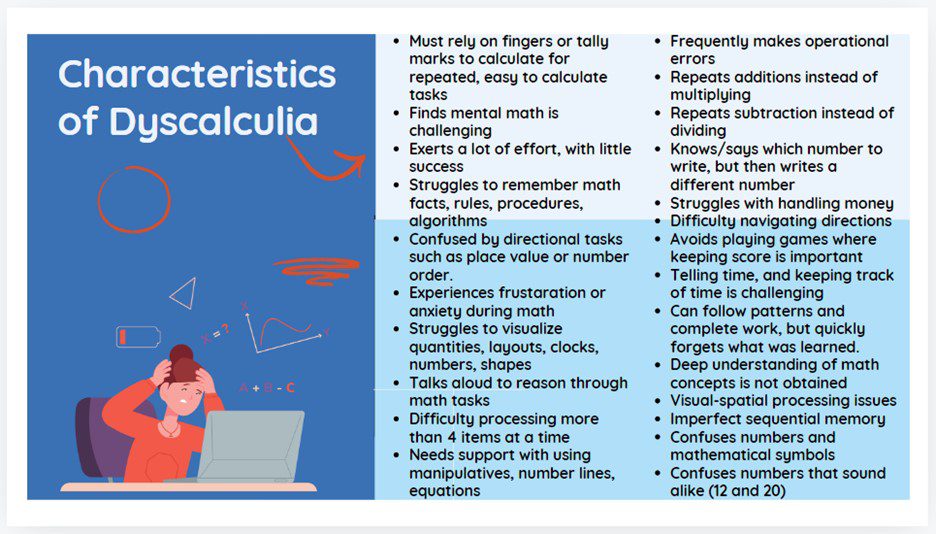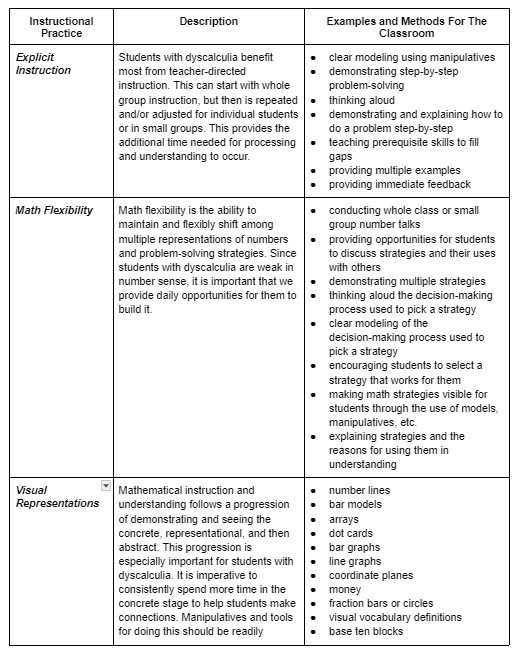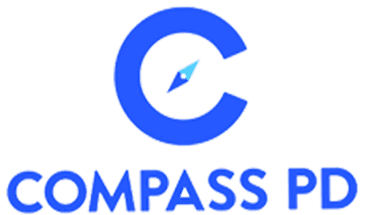Empowering Teachers to Support Students with Dyscalculia: Key Knowledge and Strategies
By Dr. Stephanie Evans
As teachers, we encounter students who struggle with math, but what happens when traditional approaches like small group instruction and scaffolding aren’t enough? For some, the difficulty runs deeper, pointing to a lesser-known learning disability: dyscalculia. Interestingly, the connection between difficulties with numbers and struggles with words is striking, as many students with dyscalculia may also have dyslexia. Dyscalculia and dyslexia frequently share common challenges related to attention, visual processing, and working memory. Research suggests that between one-third and 75 percent of students with dyscalculia also experience dyslexia, dysgraphia, or attention deficits. Since these disorders share common characteristics, some strategies we use to support students who face these challenges may look similar. With the proper understanding and approach, educators can unlock the potential of students with dyscalculia. Many of the techniques and strategies educators already use in other content areas can be applied to support students in math. Let’s delve into what dyscalculia is and how it impacts the classroom and explore strategies to help these students thrive.
Understanding Dyscalculia
Dyscalculia is a specific learning disability that makes math difficult to process and understand. This results in consistent failure to achieve in mathematics regardless of age, intelligence, instruction, or effort. There are some common misconceptions about dyscalculia. It is not just being “bad” at math. It is a neurological condition that affects number sense, mathematical reasoning, and arithmetic skills. Adults as well as children can have dyscalculia as it is a lifelong condition. It affects more than just performance in school. It impacts daily life activities such as managing money and time and even the ability to learn to drive. Students with dyscalculia are often strong and experience success in other content areas. With the right amount of support, they can also experience math success!
Identifying Dyscalculia in the Classroom
Dyscalculia affects 6% to 7% of the population, so chances are you have a student with dyscalculia in your classroom. How might this manifest in the classroom? It is sometimes difficult to determine if a student has dyscalculia because children develop at different rates. Problems will start to occur in early mathematics. You may first notice that these students have difficulty recognizing small quantities and attaching the correct name and symbol to quantities. Counting backward is challenging as it involves working memory. The criteria used to determine if a student has dyscalculia usually consists of evaluating children with an intelligence within the average range and two or more years behind grade level in math. Below is a list of characteristics these students may have.

The cause of these mathematical learning difficulties could include a deficit in basic number processing, language, memory, visual-spatial processes, or reasoning skills. Each child with dyscalculia or characteristics of dyscalculia has unique differences in how it might present itself. Teachers must consider the specific profile of the children they work with when intervening. Particular teaching strategies are effective with students with dyscalculia.
Effective Teaching Practices
There are two approaches or practices that most teachers use for teaching mathematics: traditional teacher-directed practices and inquiry or student-directed practices. Direct instruction follows an I do, we do, you do model where the teacher shows the students how to do something, the class works together on some problems, often called guided practice, and then students are set loose to work independently on problems. In student-centered instruction, the lesson begins with students working through problems on their own first, generating mathematical knowledge by drawing on what they already know and collaborating with their peers. During this process, students learn multiple strategies for solving problems. At first, the emphasis is on greater mathematical understanding rather than procedural fluency. Students with dyscalculia or who have math deficits benefit most from teacher-directed instruction. This method places less demand on attention, working memory, language, and general cognitive resources. However, students with dyscalculia benefit from learning multiple strategies as they begin to understand mathematical concepts. Some strategies most effective for students with math learning difficulties are explicit instruction, visual representation, student verbalization, using heuristics, and providing ongoing feedback. Depending on the individual student’s needs, an effective plan would include a combination of these practices, as detailed in the table below.


Additional Accommodations
Students with dyscalculia may have difficulty completing work and/or tests. Strive to provide them with more authentic ways to show their understanding, such as using manipulatives, illustrations, or making something.
To help students keep up in class, provide teacher notes, videos of math demonstrations, study guides, manipulatives, and instant access to resources such as anchor charts and videos (i.e., using hyperlinks).
Math anxiety is a natural effect of dyscalculia. When students become overwhelmed and shut down or try to avoid math, we must take steps to interrupt the cycle. The first steps are ongoing throughout the school year, including building and nurturing a strong relationship built on student trust. This allows them to feel safe to make mistakes while learning. Also, recognizing effort, celebrating small victories, and partnering with families will go a long way in easing the tensions that may arise when working in mathematics.
Educators can also interrupt the math anxiety cycle by providing opportunities for multisensory work (see, hear, physically experience, prove, model, explain, and creatively demonstrate concepts). Providing students with extended time and opportunities to work with a partner to talk through their thinking may also prove to be successful in decreasing math anxiety.
Final Thoughts
Supporting students with dyscalculia requires intentional, targeted strategies that address their unique learning needs. Techniques such as explicit instruction, developing mathematical flexibility, use of visual aids, and continual feedback can help support students with dyscalculia. By recognizing the characteristics of dyscalculia and adjusting teaching methods accordingly, educators can empower students to develop confidence and competence in mathematics, providing them with the tools they need to succeed both in and out of the classroom. As we continue to refine our teaching practices, it’s essential to keep the needs of our students with dyscalculia at the forefront, ensuring that no student is left behind on their mathematical journey.
References
Pascale Noel, M. & Karagiannakis, G. (2022). Effective Teaching Strategies for Dyscalculia and Learning Difficulties in Mathematics, Perspectives from Cognitive Neuroscience. Routledge.
Butterworth, B. (2019). Dyscalculia: from Science to Education. Routledge.
